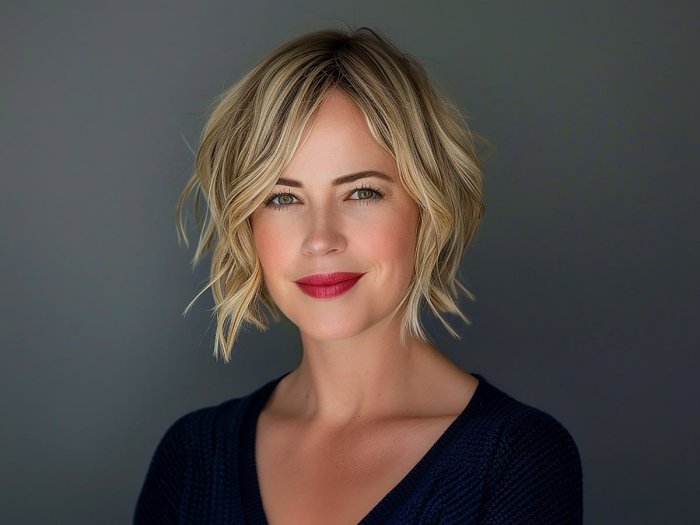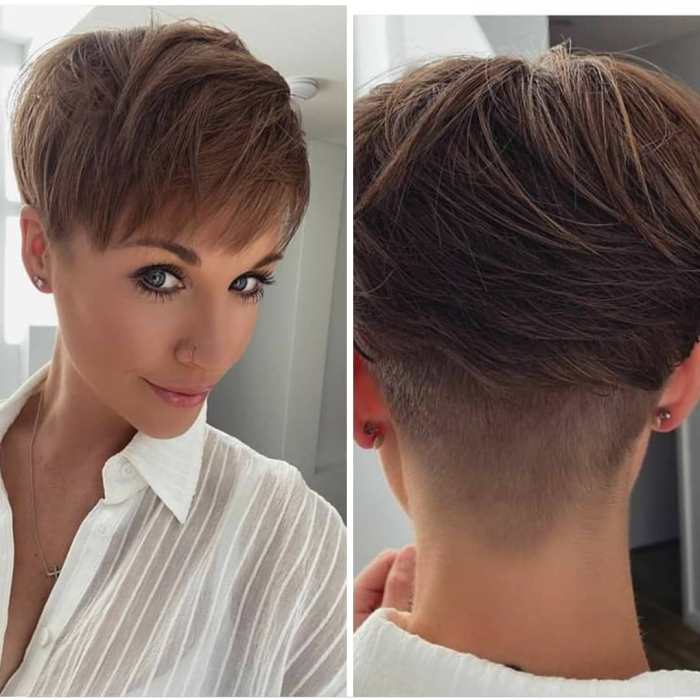Understanding Straight Fine Hair
Hairstyles for straight fine hair – Straight, fine hair, while often perceived as simple to style, presents unique challenges. Its delicate nature requires a gentle approach and specific techniques to achieve desired volume and texture. Understanding its characteristics is crucial for effective styling and maintenance.
Characteristics of Straight Fine Hair
Straight, fine hair is characterized by its thin diameter, lack of natural volume, and tendency to become limp or oily quickly. Individual strands are delicate and easily damaged by heat styling or harsh chemicals. It often lacks body and can appear flat or lifeless.
Finding the right hairstyles for straight, fine hair can be challenging, often requiring techniques to add volume and texture. However, understanding the principles of styling can help; consider exploring contrasting approaches, such as looking at solutions for managing the opposite hair type, for example, check out this guide on easy hairstyles for thick hair to see how different techniques create volume and shape.
This can offer fresh perspectives for achieving similar effects with fine hair.
Challenges in Styling Straight Fine Hair

Source: latest-hairstyles.com
The primary challenge lies in achieving and maintaining volume. Its delicate nature makes it prone to breakage and damage from excessive heat or harsh products. Styling options are often limited due to the hair’s tendency to fall flat quickly. Finding products and techniques that add body without weighing the hair down is crucial.
Types of Straight Fine Hair
Straight, fine hair can manifest in various ways, including limp, thin, and even slightly wavy variations. Limp hair lacks body and falls flat easily. Thin hair has a low density of strands, making it appear sparse. Some individuals with straight, fine hair may have a slight wave pattern, which can be manipulated for added texture.
Popular Hairstyles for Straight Fine Hair
Several hairstyles are particularly flattering and manageable for straight, fine hair. These styles often incorporate techniques that create the illusion of volume and add movement without weighing the hair down.
Ten Popular Hairstyles
Here are ten popular hairstyles suitable for straight, fine hair, categorized for clarity and understanding:
- Long layers with face-framing bangs
- Shoulder-length bob with subtle waves
- Pixie cut with textured bangs
- A-line bob with side-swept bangs
- Long, sleek straight hair with a center part
- Loose, low bun with face-framing tendrils
- High ponytail with volume at the crown
- Braided crown
- Messy bun with textured waves
- Half-updo with loose curls
Hairstyle Showcase
| Hairstyle | Description | Image Description | Face Shape Suitability |
|---|---|---|---|
| Shoulder-length layers with face-framing bangs | A soft, layered style that adds volume and movement. | Shows a woman with shoulder-length layered hair, showcasing face-framing bangs and subtle waves. | Suitable for oval, heart, and round face shapes. |
| Pixie cut with textured bangs | A short, choppy style that adds texture and volume to fine hair. | Depicts a woman with a pixie cut, showcasing textured bangs and layers for added volume. | Best for oval, heart, and diamond face shapes. |
| A-line bob with side-swept bangs | A classic bob with longer layers in the front, creating a flattering shape. | Illustrates a woman with an A-line bob, showing side-swept bangs and a sleek, polished look. | Complements oval, round, and square face shapes. |
| Long, sleek straight hair with a center part | A simple yet elegant style that works well with fine hair. | Shows a woman with long, straight hair parted in the center, emphasizing the hair’s shine and smoothness. | Suitable for oval and oblong face shapes. |
| High ponytail with volume at the crown | A versatile style that adds height and volume to the crown. | Illustrates a woman with a high ponytail, showcasing teased hair at the crown for added volume. | Flattering for most face shapes. |
Hairstyle Suitability for Different Face Shapes
Choosing a hairstyle that complements your face shape is crucial for enhancing your overall appearance. For example, layered styles generally suit most face shapes, while blunt cuts might be more suitable for certain face structures. Consulting with a hairstylist can help determine the most flattering style for your individual features.
Styling Techniques and Products
Achieving volume and texture in straight, fine hair requires careful selection of styling techniques and products. The goal is to add body without weighing the hair down or causing damage.
Five Styling Techniques for Volume and Texture
These techniques are designed to enhance the appearance of straight, fine hair:
- Root lifting sprays
- Backcombing (teasing) at the crown
- Using volumizing mousses
- Employing curling irons or wands for subtle waves
- Strategic layering from a hairstylist
Styling Product Benefits and Drawbacks
Various styling products can enhance straight, fine hair, each with its advantages and disadvantages:
- Volumizing mousse: Adds body and lift without stiffness.
- Texturizing spray: Creates grip and texture for better hold.
- Hairspray: Provides hold and shine, but can weigh hair down if overused.
- Dry shampoo: Adds texture and volume, but overuse can lead to build-up.
- Leave-in conditioner: Adds moisture and shine, but avoid heavy formulas.
Step-by-Step Guide: Voluminous Ponytail
- Apply volumizing mousse to damp hair.
- Blow-dry hair upside down for added volume at the roots.
- Gently backcomb the hair at the crown.
- Gather hair into a high ponytail and secure with an elastic band.
- Wrap a strand of hair around the elastic to conceal it.
- Finish with a light hairspray for hold.
Hair Care Routine for Straight Fine Hair
A dedicated hair care routine is essential for maintaining the health and appearance of straight, fine hair. Gentle products and regular maintenance are key to preventing damage and promoting shine.
Importance of Gentle Shampoos and Conditioners
Using gentle, sulfate-free shampoos and conditioners is crucial for preventing dryness and damage. Harsh chemicals can strip the hair of its natural oils, leading to breakage and frizz. Look for products specifically formulated for fine hair.
Benefits of Regular Trims and Deep Conditioning Treatments
Regular trims remove split ends, preventing further breakage and maintaining healthy hair growth. Deep conditioning treatments help replenish moisture and strengthen the hair shaft, adding shine and resilience.
Hairstyles for Specific Occasions
Adapting hairstyles to different occasions enhances the overall look. Here’s a breakdown of suitable options:
Formal Events
- Elegant updos
- Sleek low buns
- Hollywood waves
Everyday Casual Wear, Hairstyles for straight fine hair
- Loose braids
- Messy buns
- Half-updos
Athletic Activities
- High ponytails
- Braids
- Headbands
Color and Highlights for Straight Fine Hair
Coloring and highlighting can add dimension and volume to straight, fine hair, but it’s essential to choose the right techniques and products to avoid damage.
Hair Coloring Techniques
Techniques like balayage or subtle highlights are gentler than full-color treatments and can add depth and dimension without compromising hair health. Avoid harsh bleach-based products, which can damage fine hair.
Highlights for Adding Dimension and Volume
Strategically placed highlights can create the illusion of thicker hair by adding dimension and texture. Lighter shades around the face can also brighten the complexion and add visual lift.
Potential Risks of Coloring Fine Hair
Fine hair is more susceptible to damage from chemical treatments. Over-processing can lead to breakage, dryness, and overall damage. Always consult a professional stylist experienced in coloring fine hair.
Addressing Common Problems with Straight Fine Hair
Understanding and addressing common issues helps maintain healthy, styled hair.
Managing Frizz and Flyaways

Source: pophaircuts.com
Use anti-frizz serums or smoothing creams to control frizz and flyaways. Avoid over-washing and use a cool setting on your hairdryer.
Solutions for Limp or Lifeless Hair
Employ root-lifting techniques, use volumizing products, and consider adding layers to your haircut for added movement and body.
Preventing Hair Breakage and Damage
Use gentle hair care products, avoid excessive heat styling, and regularly trim split ends. Consider using protective serums or oils before heat styling.
Question Bank: Hairstyles For Straight Fine Hair
Can I use heat styling tools daily on fine hair?
Daily heat styling can damage fine hair, leading to breakage and dryness. Limit use and always apply a heat protectant spray beforehand.
How often should I wash my fine hair?
Washing too often can strip natural oils, leading to limp hair. Aim for every other day or every two days, depending on your hair’s oiliness.
What type of brush is best for fine hair?
A wide-tooth comb or a paddle brush with soft bristles is ideal for minimizing breakage and damage to fine hair.
Are there any specific haircuts that make fine hair look thicker?
Layered cuts, especially those with face-framing layers, can add volume and the illusion of thickness to fine hair. Avoid blunt cuts which can make hair look flatter.
